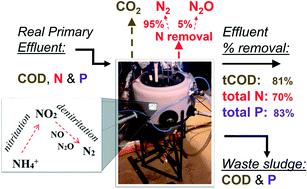当前位置:
X-MOL 学术
›
Environ. Sci.: Water Res. Technol.
›
论文详情
Our official English website, www.x-mol.net, welcomes your
feedback! (Note: you will need to create a separate account there.)
Integrated shortcut nitrogen and biological phosphorus removal from mainstream wastewater: process operation and modeling
Environmental Science: Water Research & Technology ( IF 3.5 ) Pub Date : 2019-11-25 , DOI: 10.1039/c9ew00550a Paul Roots 1, 2, 3, 4 , Fabrizio Sabba 1, 2, 3, 4 , Alex F. Rosenthal 5, 6, 7 , Yubo Wang 1, 2, 3, 4 , Quan Yuan 8, 9, 10 , Leiv Rieger 5, 6, 7 , Fenghua Yang 4, 11, 12 , Joseph A. Kozak 4, 11, 12 , Heng Zhang 4, 11, 12 , George F. Wells 1, 2, 3, 4
Environmental Science: Water Research & Technology ( IF 3.5 ) Pub Date : 2019-11-25 , DOI: 10.1039/c9ew00550a Paul Roots 1, 2, 3, 4 , Fabrizio Sabba 1, 2, 3, 4 , Alex F. Rosenthal 5, 6, 7 , Yubo Wang 1, 2, 3, 4 , Quan Yuan 8, 9, 10 , Leiv Rieger 5, 6, 7 , Fenghua Yang 4, 11, 12 , Joseph A. Kozak 4, 11, 12 , Heng Zhang 4, 11, 12 , George F. Wells 1, 2, 3, 4
Affiliation

|
While enhanced biological phosphorus removal (EBPR) is widely utilized for phosphorus (P) removal from wastewater, understanding of efficient process alternatives that allow combined biological P removal and shortcut nitrogen (N) removal, such as nitritation–denitritation, is limited. Here, we demonstrate efficient and reliable combined total N, P, and chemical oxygen demand removal (70%, 83%, and 81%, respectively) in a sequencing batch reactor (SBR) treating real mainstream wastewater (primary effluent) at 20 °C. Anaerobic – aerobic cycling (with intermittent oxic/anoxic periods during aeration) was used to achieve consistent removal rates, nitrite oxidizing organism (NOO) suppression, and high effluent quality. Importantly, high resolution process monitoring coupled to ex situ batch activity assays demonstrated that robust biological P removal was coupled to energy and carbon efficient nitritation–denitritation, not simultaneous nitrification–denitrification, for the last >400 days of 531 total days of operation. Nitrous oxide emissions of 2.2% relative to the influent TKN (or 5.2% relative to total inorganic nitrogen removal) were similar to those measured in other shortcut N bioprocesses. No exogenous chemicals were needed to achieve consistent process stability and high removal rates in the face of frequent wet weather flows and highly variable influent concentrations. Process modeling reproduced the performance observed in the SBR and confirmed that nitrite drawdown via denitritation contributed to suppression of NOO activity.
中文翻译:

从主流废水中去除氮和生物磷的综合捷径:工艺操作和建模
虽然增强型生物除磷(EBPR)被广泛用于废水中的磷(P)去除,但是对有效的工艺替代方法(包括硝化-反硝化)的有效理解是有限的,该替代方法可以实现生物除磷和捷径氮(N)的联合去除。在这里,我们证明了在顺序分批反应器(SBR)中处理20°C的实际主流废水(一次流出)时,有效,可靠地去除了总氮,磷和化学需氧量的组合(分别为70%,83%和81%) C。厌氧-好氧循环(曝气期间有间歇性的有氧/缺氧时间)可实现一致的去除率,亚硝酸盐氧化生物(NOO)抑制和高废水质量。重要的是,高分辨率过程监控与异地耦合批处理活性分析表明,在531个工作日的最后> 400天中,强劲的生物P去除与能量和碳有效的硝化-反硝化作用同时发生,而不是同时硝化-反硝化作用。相对于进水TKN的一氧化二氮排放量为2.2%(相对于总无机氮去除量为5.2%)与其他捷径N生物过程中测得的排放量相似。面对频繁的潮湿天气流量和进水浓度变化很大,不需要外源化学物质即可获得一致的工艺稳定性和高去除率。过程建模再现在SBR中观察到的性能,并证实亚硝酸盐缩编经由denitritation促成NOO活性的抑制。
更新日期:2019-11-25
中文翻译:

从主流废水中去除氮和生物磷的综合捷径:工艺操作和建模
虽然增强型生物除磷(EBPR)被广泛用于废水中的磷(P)去除,但是对有效的工艺替代方法(包括硝化-反硝化)的有效理解是有限的,该替代方法可以实现生物除磷和捷径氮(N)的联合去除。在这里,我们证明了在顺序分批反应器(SBR)中处理20°C的实际主流废水(一次流出)时,有效,可靠地去除了总氮,磷和化学需氧量的组合(分别为70%,83%和81%) C。厌氧-好氧循环(曝气期间有间歇性的有氧/缺氧时间)可实现一致的去除率,亚硝酸盐氧化生物(NOO)抑制和高废水质量。重要的是,高分辨率过程监控与异地耦合批处理活性分析表明,在531个工作日的最后> 400天中,强劲的生物P去除与能量和碳有效的硝化-反硝化作用同时发生,而不是同时硝化-反硝化作用。相对于进水TKN的一氧化二氮排放量为2.2%(相对于总无机氮去除量为5.2%)与其他捷径N生物过程中测得的排放量相似。面对频繁的潮湿天气流量和进水浓度变化很大,不需要外源化学物质即可获得一致的工艺稳定性和高去除率。过程建模再现在SBR中观察到的性能,并证实亚硝酸盐缩编经由denitritation促成NOO活性的抑制。











































 京公网安备 11010802027423号
京公网安备 11010802027423号